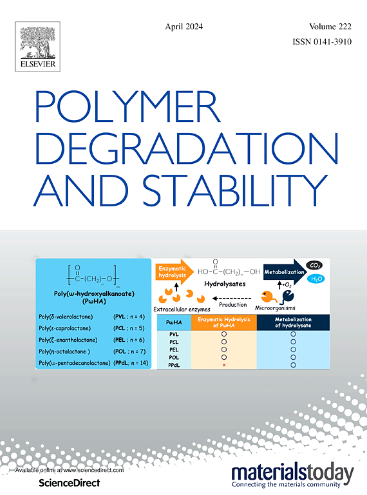Stabilization of PE with the natural antioxidant t-resveratrol: Interaction of the primary and the secondary antioxidant
IF 7.4
2区 化学
Q1 POLYMER SCIENCE
引用次数: 0
Abstract
The study focuses on the possibility of using resveratrol, a stilbenoid-type natural antioxidant, as a stabilizer in polyethylene. The experiments were carried out in two stages. First, the efficiency of the natural antioxidant was compared to that of a commercial product, and then polymer properties were determined as a function of additive content. Stabilization efficiency was determined by multiple extrusion experiments. Resveratrol proved a very efficient stabilizer, more efficient than the commercial hindered phenolic antioxidant. Resveratrol provides excellent processing stability and the residual stability of PE containing it is exceptional. Because of its large efficiency, 400–500 ppm additive is sufficient to achieve adequate stability for practice. Resveratrol interacts with the secondary phosphorous stabilizer used in the study, and the effect is antagonistic; resveratrol performs better alone than in combination with PEPQ. Accordingly, this unusual effect must be taken into account during formulation and the construction of the actual additive package. Resveratrol is used in other industries, thus it is available in large quantities and relatively cheap. Besides its advantages, the natural antioxidant has some drawbacks, like its high melting temperature, limited solubility in polyethylene, and strong color of its reaction products. Nevertheless, resveratrol has great potential as a stabilizer in certain products.
用天然抗氧化剂 t-白藜芦醇稳定聚乙烯:一级和二级抗氧化剂的相互作用
这项研究的重点是将白藜芦醇这种类芪类天然抗氧化剂用作聚乙烯稳定剂的可能性。实验分两个阶段进行。首先,将天然抗氧化剂的效率与商用产品的效率进行比较,然后根据添加剂含量确定聚合物特性。通过多次挤压实验确定了稳定效率。结果表明,白藜芦醇是一种非常有效的稳定剂,比商用受阻酚类抗氧化剂更有效。白藜芦醇具有出色的加工稳定性,含有白藜芦醇的聚乙烯的残留稳定性也非常出色。由于白藜芦醇的效率很高,在实际应用中,400-500 ppm 的添加剂就足以达到足够的稳定性。白藜芦醇会与研究中使用的二级磷稳定剂发生作用,而且这种作用是拮抗的;白藜芦醇单独使用的效果要好于与 PEPQ 合用的效果。因此,在配制和构建实际的复合添加剂时,必须考虑到这种不寻常的效应。白藜芦醇在其他行业中也有应用,因此它的用量大,价格相对便宜。除了优点之外,这种天然抗氧化剂也有一些缺点,如熔点高、在聚乙烯中的溶解度有限以及反应产物颜色较深。不过,白藜芦醇作为某些产品的稳定剂具有很大的潜力。
本文章由计算机程序翻译,如有差异,请以英文原文为准。
求助全文
约1分钟内获得全文
求助全文
来源期刊

Polymer Degradation and Stability
化学-高分子科学
CiteScore
10.10
自引率
10.20%
发文量
325
审稿时长
23 days
期刊介绍:
Polymer Degradation and Stability deals with the degradation reactions and their control which are a major preoccupation of practitioners of the many and diverse aspects of modern polymer technology.
Deteriorative reactions occur during processing, when polymers are subjected to heat, oxygen and mechanical stress, and during the useful life of the materials when oxygen and sunlight are the most important degradative agencies. In more specialised applications, degradation may be induced by high energy radiation, ozone, atmospheric pollutants, mechanical stress, biological action, hydrolysis and many other influences. The mechanisms of these reactions and stabilisation processes must be understood if the technology and application of polymers are to continue to advance. The reporting of investigations of this kind is therefore a major function of this journal.
However there are also new developments in polymer technology in which degradation processes find positive applications. For example, photodegradable plastics are now available, the recycling of polymeric products will become increasingly important, degradation and combustion studies are involved in the definition of the fire hazards which are associated with polymeric materials and the microelectronics industry is vitally dependent upon polymer degradation in the manufacture of its circuitry. Polymer properties may also be improved by processes like curing and grafting, the chemistry of which can be closely related to that which causes physical deterioration in other circumstances.
 求助内容:
求助内容: 应助结果提醒方式:
应助结果提醒方式:


